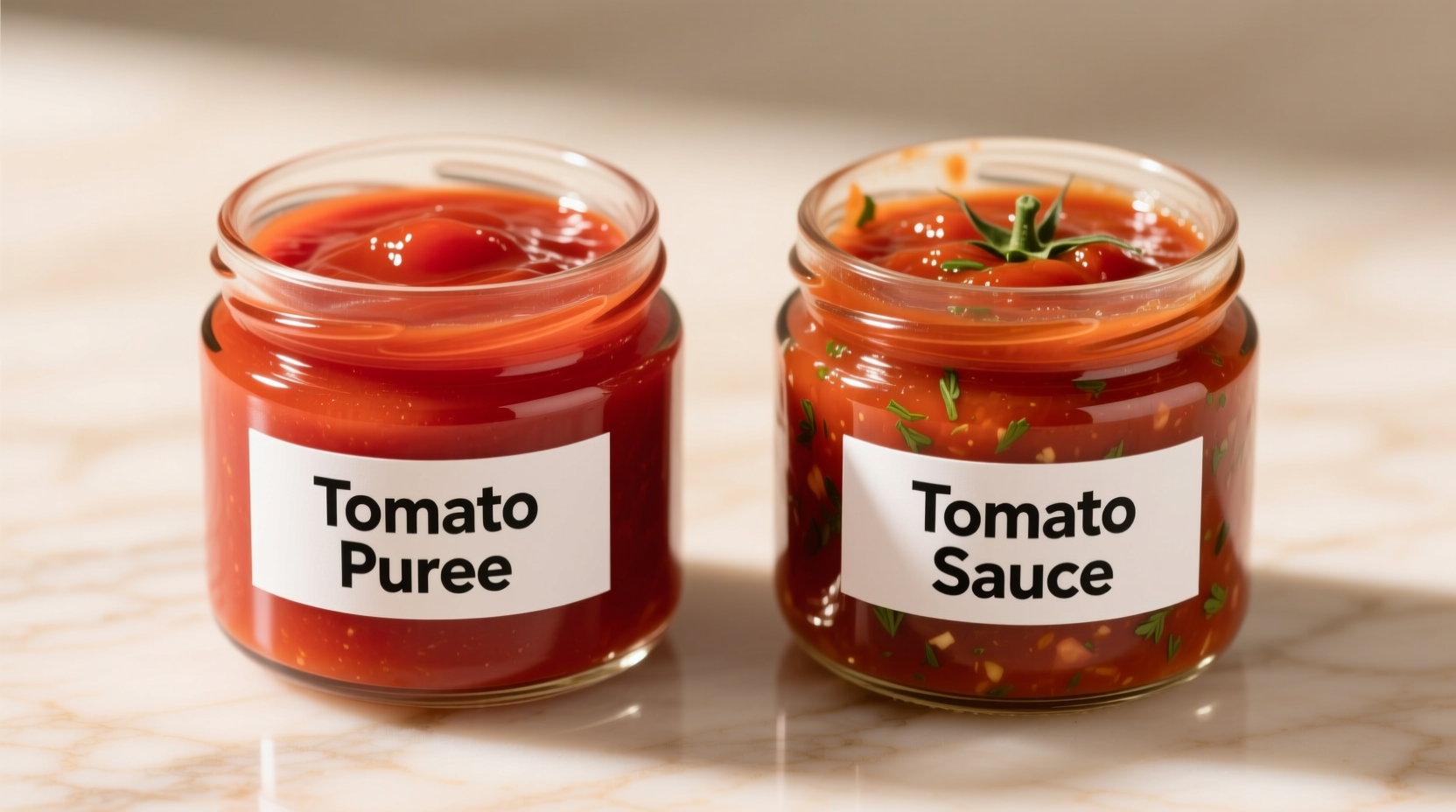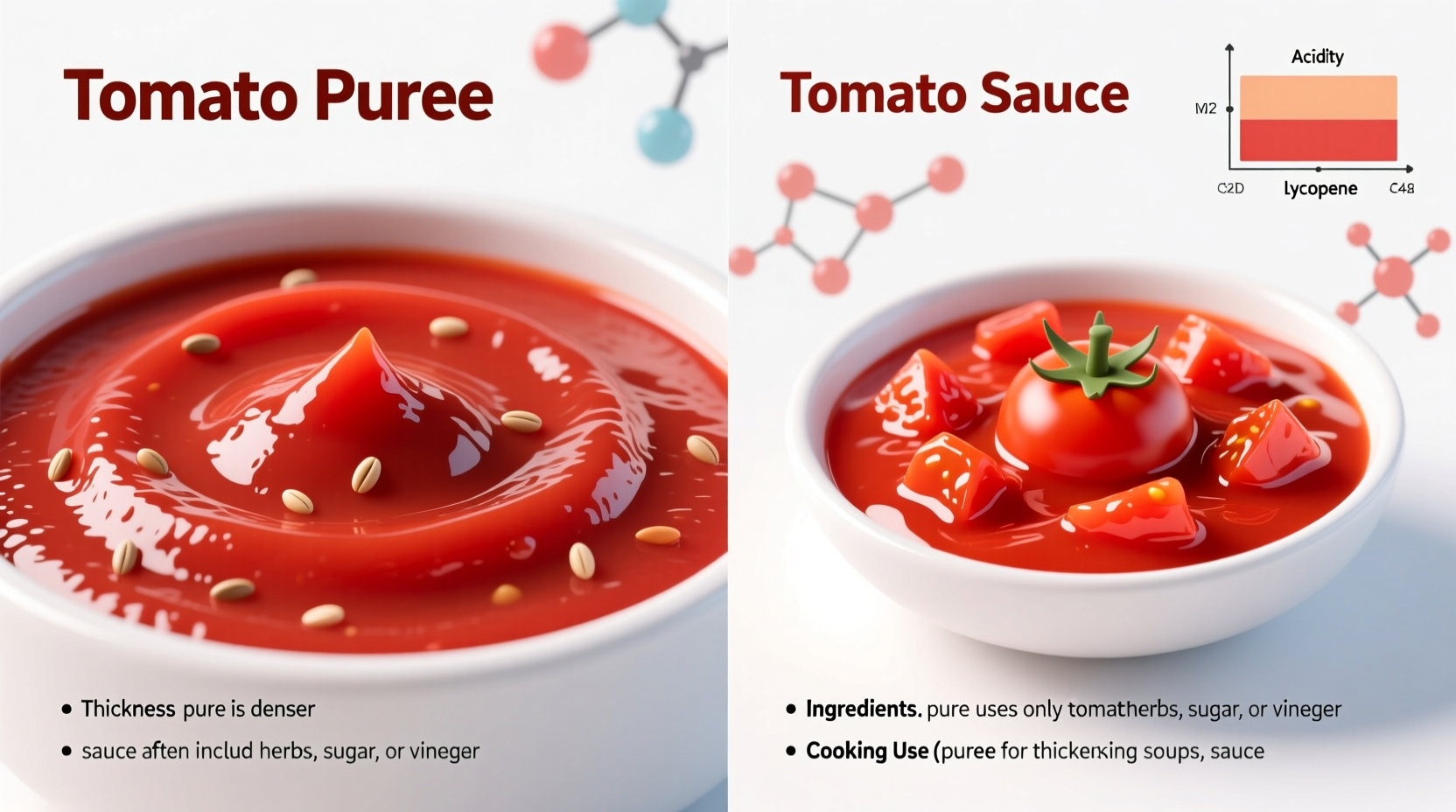Why This Distinction Matters in Your Cooking
Getting tomato puree and tomato sauce confused can completely alter your dish's outcome. That pasta sauce might turn out too watery, or your pizza base could become unexpectedly seasoned. As a chef with years of experience in professional kitchens, I've seen how this simple misunderstanding affects home cooks daily.
Breaking Down the Core Differences
Let's examine exactly what separates these two pantry staples. The distinction goes beyond just texture—it affects flavor profiles, cooking times, and recipe success.
| Characteristic | Tomato Puree | Tomato Sauce |
|---|---|---|
| Ingredients | 100% tomatoes, cooked and strained | Tomato puree plus seasonings (onions, garlic, herbs) |
| Texture | Thick, smooth concentrate | Thinner, more liquid consistency |
| Flavor Profile | Intense tomato flavor, slightly acidic | Balanced with additional seasonings |
| Preparation Time | Requires additional cooking and seasoning | Ready to use immediately |
| Typical Use Cases | Base for sauces, soups, stews | Pasta dishes, pizza, ready-to-use applications |
Tomato Puree: The Culinary Workhorse
Tomato puree serves as the blank canvas of the tomato product world. According to the USDA FoodData Central database, commercial tomato puree contains only tomatoes with no added ingredients, typically processed by cooking ripe tomatoes, removing skins and seeds, then straining to achieve that signature smooth texture.
Professional chefs prize tomato puree for its versatility. When developing recipes, I often start with puree because it gives me complete control over seasoning. Want a spicy arrabbiata? Add red pepper flakes. Creating a delicate bisque? Keep it simple with just puree and cream. This flexibility makes puree indispensable in serious cooking.

Tomato Sauce: The Ready-to-Use Solution
Tomato sauce takes tomato puree and builds upon it with additional ingredients. The Food and Drug Administration's standards indicate that commercial tomato sauce typically contains tomato puree plus seasonings like onions, garlic, herbs, and sometimes sugar to balance acidity.
This pre-seasoned nature makes tomato sauce perfect for quick weeknight meals. When you're short on time but still want flavorful results, tomato sauce delivers consistent flavor without requiring additional preparation. Just heat and serve—ideal for busy home cooks who want restaurant-quality results with minimal effort.
When to Choose Each Product: Practical Kitchen Guidance
Understanding the appropriate context for each product separates novice cooks from seasoned kitchen professionals. Consider these real-world scenarios:
Pizza Making
For authentic Neapolitan pizza, tomato puree is essential. The Associazione Verace Pizza Napoletana specifies using only San Marzano tomatoes processed into puree, with no additional ingredients. This allows the natural sweetness of the tomatoes to shine through without competing flavors.
Pasta Dishes
Quick pasta dishes benefit from tomato sauce's ready-to-use nature. However, for more complex sauces like a slow-simmered ragù, starting with tomato puree gives you better control over flavor development. Serious Eats' culinary testing consistently shows that building sauce from puree creates deeper, more nuanced flavors.
Soup and Stew Applications
When making tomato-based soups or stews, tomato puree provides concentrated tomato flavor without introducing competing seasonings. This allows you to build your flavor profile from scratch, creating a more cohesive final dish.
Substitution Strategies That Actually Work
Running out of one product doesn't mean your recipe is ruined. Here's how to make effective substitutions:
- Tomato sauce for puree: Simmer 1 cup of tomato sauce until reduced by half (about 15-20 minutes), then strain through a fine mesh sieve to remove herbs and seasonings
- Tomato puree for sauce: Mix 1 cup puree with ¼ cup water, 1 minced garlic clove, 1 tsp dried basil, and a pinch of salt, then simmer for 10 minutes
- For pizza: Never substitute—authentic pizza requires the clean tomato flavor only puree provides
Avoid These Common Mistakes
Based on testing in professional kitchens, these errors frequently undermine recipe success:
- Using tomato sauce when a recipe calls for puree, resulting in overly seasoned dishes
- Not adjusting liquid content when substituting between products
- Assuming all "tomato products" are interchangeable
- Using double-concentrated puree without adjusting quantities
Reading Labels Like a Pro
Not all products labeled "tomato sauce" or "tomato puree" are created equal. When shopping, check the ingredient list:
- True tomato puree should list only "tomatoes" or "tomato puree"
- Tomato sauce will include additional seasonings
- Beware of "tomato cooking sauce" which often contains sugar and preservatives
- "Passata" is similar to puree but typically less concentrated
Storage and Shelf Life Considerations
Both products have different storage requirements that affect their usability:
- Unopened tomato puree: 12-18 months in pantry
- Opened tomato puree: 5-7 days refrigerated or 6 months frozen
- Unopened tomato sauce: 12 months in pantry
- Opened tomato sauce: 5-7 days refrigerated
For frequent users, freezing puree in ice cube trays provides portion-controlled amounts perfect for single recipes.
Creating Restaurant-Quality Results at Home
The difference between adequate and exceptional tomato-based dishes often comes down to selecting the right product. When developing recipes for home cooks, I emphasize understanding these distinctions because they directly impact your cooking success.
Remember: tomato puree gives you creative control for building complex flavors from scratch, while tomato sauce offers convenience for quick, consistent results. Neither is "better"—they simply serve different culinary purposes.











 浙公网安备
33010002000092号
浙公网安备
33010002000092号 浙B2-20120091-4
浙B2-20120091-4